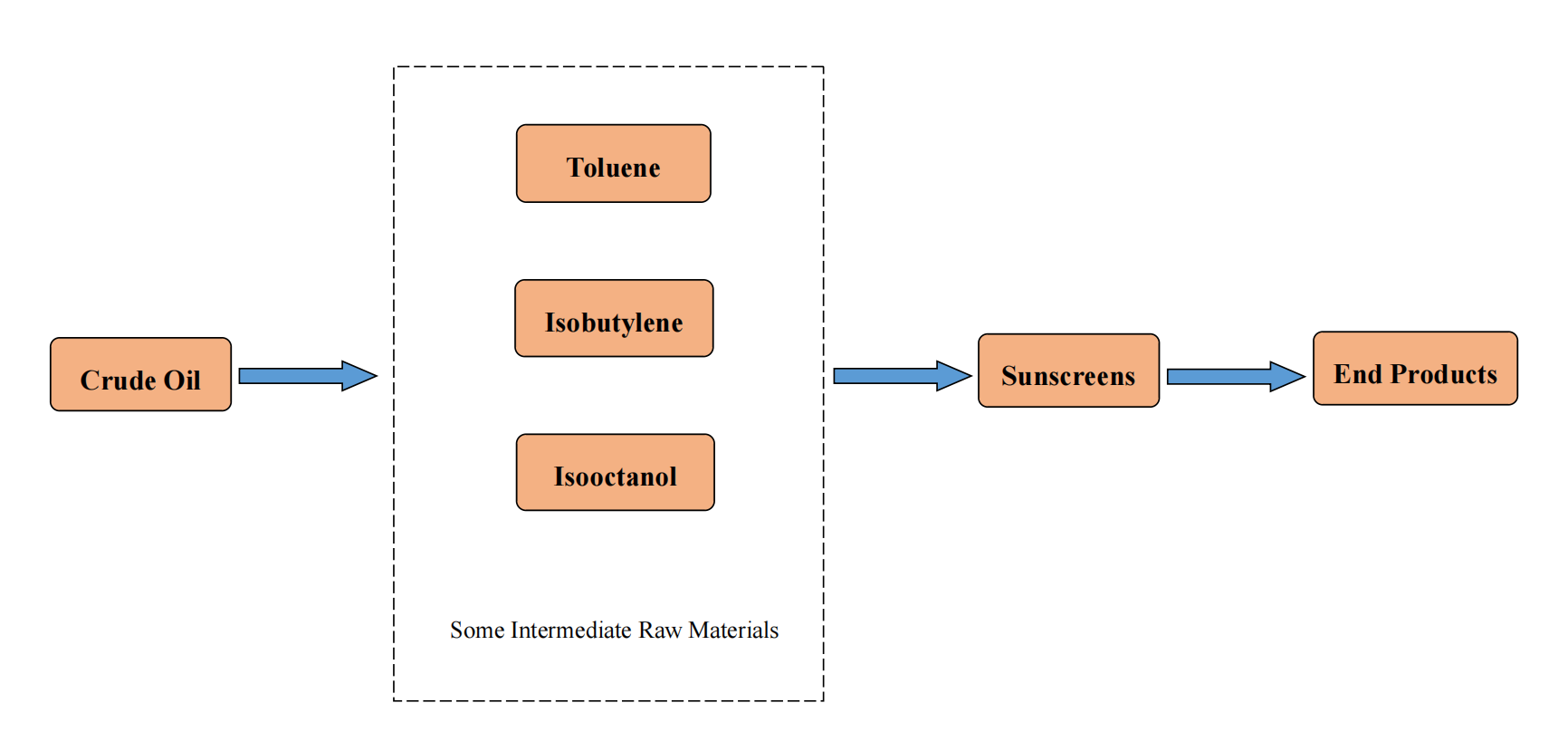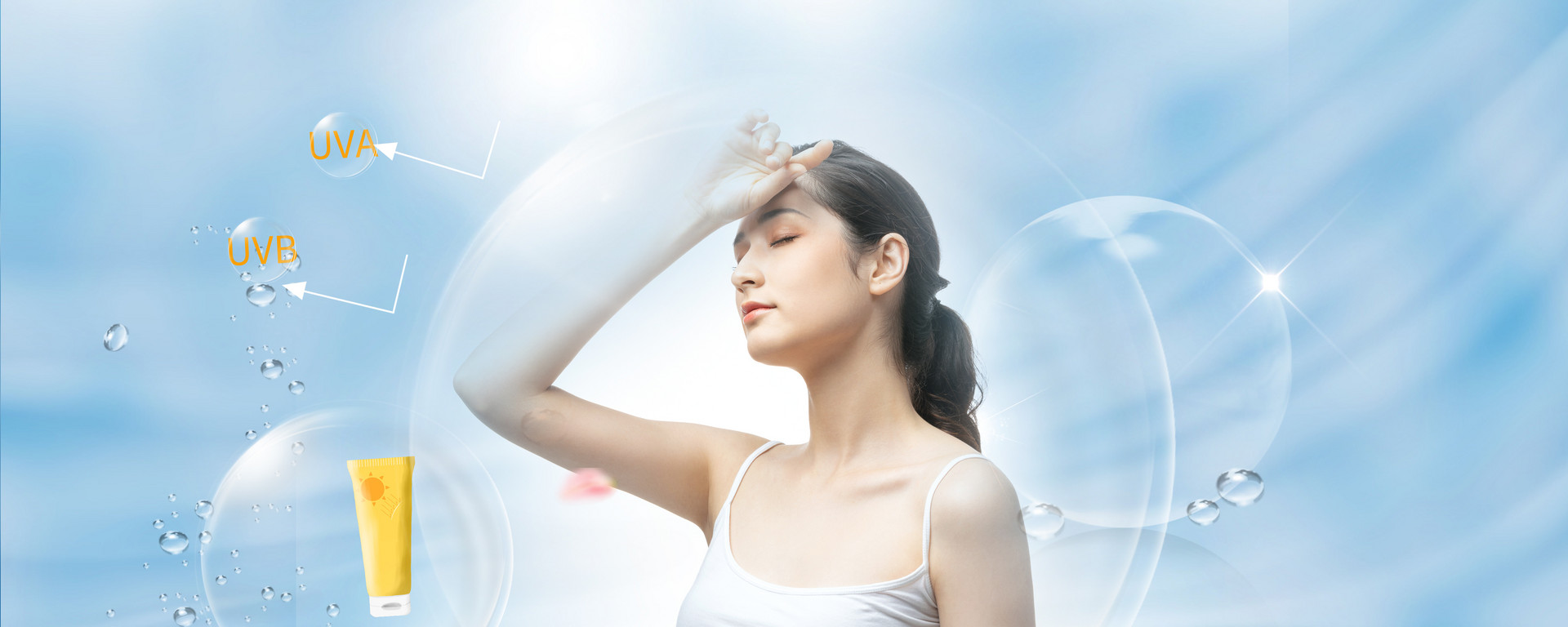Sunscreen agents are active ingredients in special-purpose cosmetics. They mainly prevent ultraviolet rays from causing damage to the skin. They are synthesized through chemical reactions using crude oil as raw materials.
The approval of sunscreen products is strict. In China, they need to be approved by the State Food and Drug Administration before they can enter the market. They are classified as “special purpose cosmetics”.
Most chemical sunscreens on the market are extracted from crude oil to intermediate products such as toluene and isobutylene, and are formed into sunscreens through a series of chemical synthesis technologies, then added to sunscreen products in various forms such as creams and sprays. Therefore, the cost of sunscreen products is closely related to the price of upstream crude oil.
Sunscreen Industry Chain:
From the perspective of sunscreen band coverage: Ultraviolet rays can be divided into high-frequency short-wave ultraviolet (UVC), medium-frequency mid-wave ultraviolet (UVB) and low-frequency long-wave ultraviolet (UVA) according to different wavelengths. UVC is usually blocked by the ozone layer and does not reach the earth’s surface, while UVB and UVA can penetrate the ozone layer and irradiate the human body.
Since the damage caused by ultraviolet rays to the skin is mainly divided into two types of invisible light, UVA and UVB, whether it can protect both UVA and UVB at the same time has become one of the indicators for judging the sun protection ability of sunscreen agents. Some sunscreens can protect against skin damage caused by both UVA and UVB, while some products cannot cover the entire spectrum.
The Difference between UVA and UVB in the Field of Sun Protection:
| Wavelength | Skin Penetration | Skin Damage | Sign | |
| UVA | Ultraviolet Radiation A, 320nm ~ 400nm | The penetrating power is relatively strong and can reach the dermis layer | It is easy to precipitate melanin and stains in the short term, and cause photoaging in the long term. | The application time in the sun protection field is earlier, with the universal SPF logo. |
| UVB | Ultraviolet Radiation B, 280nm ~ 320nm | The penetrating power is relatively weak and can reach the epidermis layer | Carrying high energy, can easily cause sunburn in the short term and photoaging in the long term. | In the field of sun protection, the application time is later, with signs such as PA+. |
From the perspective of the sun protection principle of sunscreen agents: sunscreen agents can be divided into physical sunscreen agents and chemical sunscreen agents. China’s State Food and Drug Administration has approved the use of 27 types of sunscreens, including two categories of inorganic sunscreens and 25 categories of organic sunscreens. Physical sunscreens achieve physical shielding effects by reflecting or refracting ultraviolet rays, and only include zinc oxide and titanium dioxide; while chemical sunscreens achieve sunscreen effects by absorbing ultraviolet rays, and there are many types for this series products.
| Category | Anti-UVA | Anti-UVB | Protects Against UVA & UVB |
| Physical Sunscreens | - | - | 1) Zinc Oxide (ZnO); 2) Titanium Dioxide (TiO2) |
| Chemical Sunscreens | 1) Diethylaminohydroxybenzoyl hexyl benzoate (UVA Plus); 2) Avobenzone; 3) Benzophenone-6 (BP-6); 4) Disodium Phenyl Dibenzimidazole Tetrasulfonate (DPDT), etc | 1) Homosalate; 2) 2-Ethylhexyl Salicylate (Octyl Salicylate/Octisalate); 3) Ethylhexyl Methoxycinnamate (OMC); 4) Diethylhexyl Butamido Triazone (Iscotrizinol); 5) Ethylhexyl Triazone (Uvinul T 150), etc | 1) Octocrylene; 2) Bis-ethylhexyloxyphenol Methoxyphenyl Triazine (Bemotrizinol); 3) Benzophenone-3 (UV-9); 4) Benzophenone-4 (UV-284); 5) 2-Phenylbenzimidazole-5-Sulfonic Acid (Ensulizole), etc |
Since 2012, the global beauty care market has generally maintained steady growth. According to Statista data, the global beauty care market size will be US$136.4 billion in 2021. The scale declined in 2015 and 2020, in 2015, the continued sluggish demand in the Eurozone and the sharp economic recession in Brazil, one of the major cosmetics markets, led to a sharp decline in the scale of global beauty care, with a year-on-year decrease of 8.5%; In 2020, affected by the epidemic, global market demand was weak, with the world declining by 3.8% year-on-year. Statista data predicts that the global beauty care market will reach US$187.7 billion in 2026, and the CAGR from 2021 to 2026 is expected to be 11.23%, showing a rapid growth trend.
Post time: Nov-26-2023




